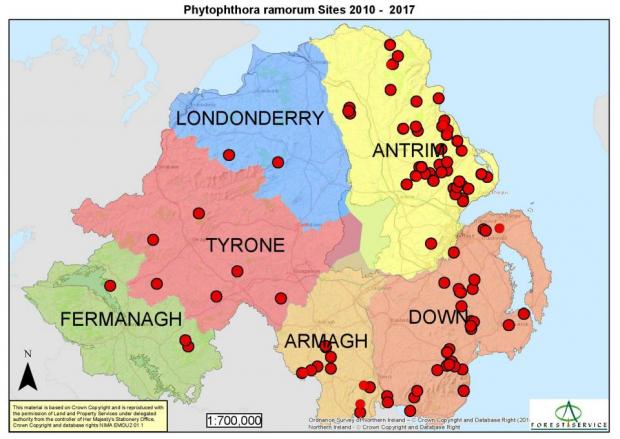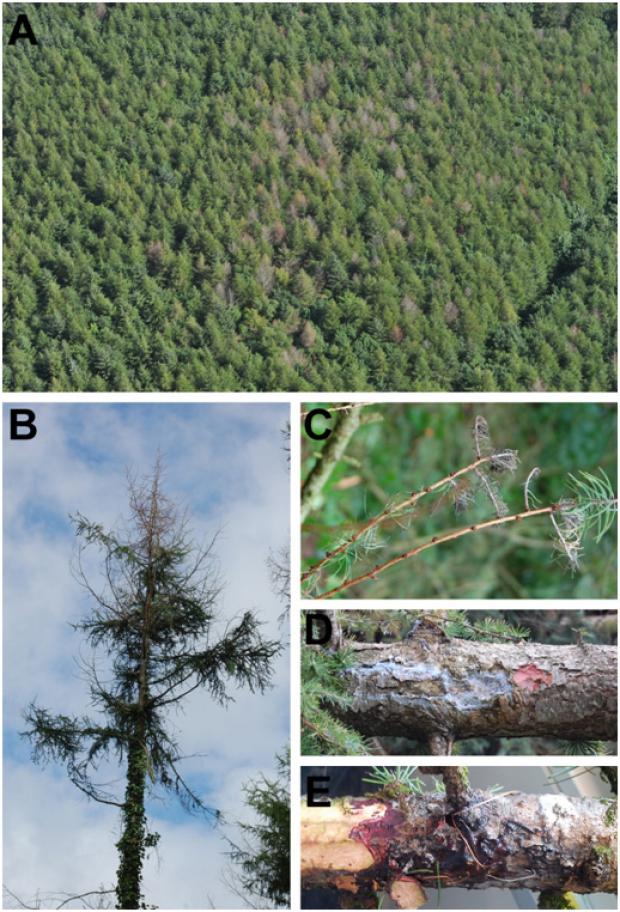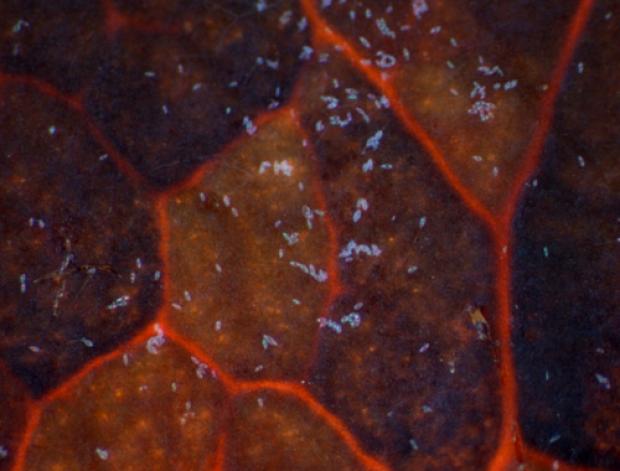Description
Sudden larch death is a disease of several host trees and plants including larch (all species), beech, chestnut and woody ornamentals including rhododendron, Camellia and Viburnum. It is caused by the fungus –like organism, Phytophthora ramorum. In North America the pathogen mainly affects oak and tanoak, giving it the common name Sudden Oak Death. In the UK the pathogen is not a large threat to oak species, and is more damaging to the coniferous plantation species Larch where it causes a disease known as Sudden Larch Death.
Threat
The host range of P. ramorum is extremely wide, with the current host range including hundreds of host genera. In Ireland, the pathogen has been detected on 30 different hosts. Sudden Larch death is a large threat to commercial forestry in Northern Ireland. To date, over 1000 ha of Larch have been removed because of efforts to eradicate the disease. The pathogen is also a threat to the wider environment, as important tree (beech, oak) and woody shrub (bilberry, heather) species are susceptible to infection.
Distribution
The progression of numbers and appearance of new infected sites over time should not be interpreted as an indication of the rate of spread of the disease. It only indicates when infection sites were found, not when the pathogen first arrived at the site, which in many cases cannot be known.

Susceptible species
The host range of P. ramorum is extremely wide. Many tree and woody shrub species are susceptible to the pathogen.
Spread
Spread at the local scale of meters is mainly by movement in rain splash, wind and in watercourses. Spread over large distances of many kilometres can be by movement of infected plant material, or as infected soil and debris on boots and tyres. There is some evidence from the UK and North America that the pathogen can spread several kilometres in wind-blown rain and mist.
Outbreak stage and national plans
Phytophthora ramorum was confirmed for the first time in Northern Ireland in rhododendron plants in the nursery trade in late 2002. In August 2010 the first confirmation of the disease in Japanese larch was made in a plantation on the Antrim plateau.
Aerial surveillance of public and private forests is carried out twice a year in June and September with follow up ground inspections of suspect cases. Phytophthora ramorum has been identified in larch in all six counties. It has also been identified in other plant species.
There have been 1,000 hectares of larch trees affected to date, with felling still underway in a number of forests. Further action will be taken forward on a prioritised basis.
The pathogen has also been detected in plant nurseries across 20 European countries, including Northern Ireland.
Symptoms
The symptoms observed of a P. ramorum infection vary enormously between hosts. On rhododendron symptoms range from blackening of the leaves, to wilting stems with a typical shepherd’s crook and shoot death. On Japanese larch an infection with P. ramorum results in several different symptoms:
- Often the first indication of an infection is that trees shed their needles resulting in the thinning of the crown of individual trees, groups of trees or the entire Japanese larch woodland canopy.
- Infected trees will form excessive numbers of cones
- There will be evidence of bleeding cankers on the main trunk of infected trees, although because these are often most prolific at the top of the trees, they are often difficult to see before the tree is felled
- Needles which become infected turn brown and are often shed prematurely

Reporting suspect cases
If you think you have spotted the disease, please check our symptoms section before reporting it using TreeCheck or one of the Further Information contact points below.
Management, grants, treatment
No cure has been found and there are no effective chemical treatments available. There are fungicides which can suppress the symptoms, but none will kill the pathogen. So the objective of any control approach must be to prevent or minimise any further spread of P. ramorum and the damage it causes. The best available scientific advice is to remove and kill the living plant tissue on which the organism depends for reproduction. In the case of infected larch, this means affected trees should be felled or otherwise killed as quickly as possible after detection of the disease and before the next spring or autumn period of sporulation begins on the needles.

The science
There are four closely related populations (EU1, EU2, NA1, NA2) of P. ramorum known world-wide. The EU1 lineage is found in European nurseries, in forests in Ireland, and in a localised forest outbreak in the USA. The EU2 lineage is only found in Northern Irish and Scottish forests. The NA1 lineage is found in North American plant nurseries and forests. The NA2 lineage is only found in North American nurseries, with localised outbreaks outside of nurseries. The fungus is biologically heterothallic, meaning that it needs two opposite mating types to complete sexual reproduction. The EU1 and EU2 mating types are A1 type, while the NA1 and NA2 mating types are A2 type. However, sexual reproduction has never been observed in the wild, and is extremely rare even in ideal conditions in the laboratory. The pathogen mainly reproduces asexually (clonally), by production of sporangia and chlamydospores.
Chalmydospores are a particularly resistant spore type, and contribute to the survival of the pathogen in unfavourable conditions. In infected forests, the pathogen may survive for several years as chlamydospores in infected plant debris.
Origins
It is impossible to ascertain when P. ramorum first entered the UK or where it came from. However, contrary to some views, research has shown that it did not arrive here from the USA, where different forms of the pathogen occur. The evidence suggests that P. ramorum is native to another part of the world, possibly Asia. Other European countries (Germany and The Netherlands) are now known to have had findings of the pathogen (as a then unknown Phytophthora) on shrubs dating back to 1993, but these are also likely to have been introduced.
Pest risk analysis
A European Pest Risk Assessment was carried out in 2009. This PRA was carried out before the pathogen host jumped to Larch.
Import & movement restrictions
As P. ramorum is a regulated pest under EU legislation, there are a number of rules related to the import and movement of plants or plant material that is a risk for spreading P. ramorum.
Further information
Questions and answers
Contact:Plant Health Information Unit
DAERA Northern Ireland
Tel: 0300 200 7847
Email: planthealth@daera-ni.gov.uk
